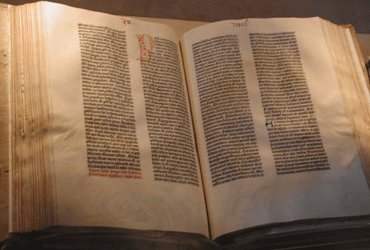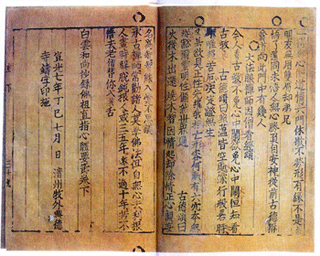|
Gutenberg Bible
Answer
to Name
This Famous Antique Game - April 2013
by Mike McLeod
Julie Kimbrell of Old School Antiques of Sylva, N.C., Teresa P. Bland, a collector, Ted Carlton of Utah and Nevada, Scott and Carolyn Brown of Memories Flea An'Tique Mall in Prattville, Ala., and Sherron Lawson Roswell, Ga., correctly identified the Gutenberg Bible.
 Printing of the Gutenberg Bible began in about 1452 after Johannes Gutenberg created his printing press with moveable type in about 1450 in modern-day Germany. Up to that point in time, Bibles were handwritten, usually by monks, taking at least a year to complete. Printing of the Gutenberg Bible began in about 1452 after Johannes Gutenberg created his printing press with moveable type in about 1450 in modern-day Germany. Up to that point in time, Bibles were handwritten, usually by monks, taking at least a year to complete.
Gutenberg’s Bibles, of which less than 200 were printed, retailed at the equivalent of about 3.375 oz. of gold each, or about $5,285 at today’s gold price. As you can see, this was a huge cost for a book then, as it would be now. But bear in mind that it required almost three years of work by Gutenberg and his crew, which has been estimated at about 25 men, to print and bind the 1,284 pages of his Bible in two volumes.
In 1987, a complete Gutenberg Bible sold for $5.39 million. Only 47 or 48 of his Bible are still in existence now; 21 are complete. Two are in the British Museum in London. Individual pages have been known to sell for $25,000 each. A complete two-volume set Gutenberg Bible would probably sell for somewhere above $35 million.
Other examples of Gutenberg’s work, indulgences, are on display in the British Library in London. Those indulgences measure 6 3/16 by 9 1/4 inches and were sold on April 29, 1455; they granted a release from punishment in Purgatory for repented sins. The selling of these indulgences was granted to John II, King of Cyprus, by Pope Nicholas V to fund the purchase of weapons and the building of defenses in Cyprus against a Turkish invasion.1
The selling of indulgences was a main focus of Martin Luther’s Ninety-Five Theses on the Power and Efficacy of Indulgences which led to his excommunication and the eventual start of the Reformation.
The first recorded moveable type. Alas, Johannes Gutenberg was not the first to create moveable type. Between 1041 and 1048 A.D. during the Song Dynasty, Bi Sheng, a commoner with an unrecorded ancestry, made thin porcelain type for printing.2 This was after he invented and then rejected wood as a medium for creating type because of the grain and its tendency to deteriorate.
The first recorded metal type was made in Korea and is attributed to a civil minister Choe Yun-ui. With other scholars, he published Sangjeong Gogeum Yemun (“Prescribed Ritual Text of the Past and Present”), a 50-volume set, in about 1234 A.D.3
|

|
The oldest existing typeset book, Jikji, published in 1377 in Korea, predates Johannes Gutenburg's work.
|
The oldest existing book printed with metal type is Jikji (loosely translated as, "Anthology of Great Buddhist Priests' Zen Teachings"), a Korean text printed in 1377.4 It was written by Baegun, a Buddhist monk, and it was printed by him with assistance from Seoksan and Daldam who were priests in the Heungdeok Temple, a female priest called Myodeokt, and Baegun’s students.
--------------------------------
1 The British Library, www.bl.uk/treasures/gutenberg/indulgences.html
2 Worldwide Independent Inventers Association, http://www.worldwideinvention.com/famous_inventors/details/323/
3 http://yawiki.org/Cloe_Yun-ui
|